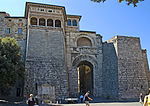Cippus Perusinus
1822 archaeological discoveries2nd-century BC steles3rd-century BC stelesEtruscan inscriptionsPerugia ... and 1 more
Steles

The Cippus Perusinus is a stone tablet (cippus) discovered on the hill of San Marco, near Perugia, Italy, in 1822. The tablet bears 46 lines of incised Etruscan text, about 130 words. The cippus is assumed to be a text dedicating a legal contract between the Etruscan families of Velthina (from Perugia) and Afuna (from Chiusi), regarding the sharing or use of a property upon which there was a tomb belonging to the noble Velthinas.The date of the inscription is considered to be 3rd or 2nd century BC. The Cippus is conserved in the National Archeological Museum of Perugia.
Excerpt from the Wikipedia article Cippus Perusinus (License: CC BY-SA 3.0, Authors, Images).Cippus Perusinus
Strada Perugia - San Marco, Perugia San Marco
Geographical coordinates (GPS) Address Nearby Places Show on map
Geographical coordinates (GPS)
| Latitude | Longitude |
|---|---|
| N 43.1275 ° | E 12.365833333333 ° |
Address
Strada Perugia - San Marco
Strada Perugia - San Marco
06125 Perugia, San Marco
Umbria, Italy
Open on Google Maps










